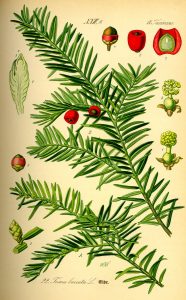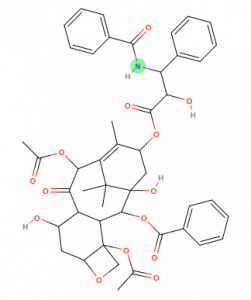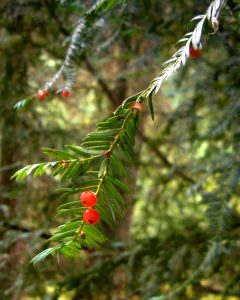Taxus brevifolia, commonly known as the Pacific Yew or Western Yew is part of the Taxaceae family. This family, known for it’s red, berry-like seed cones (Epel, 1996) is one that has both a far reaching history and an interesting future. Our English neighbors have Taxus baccata which has similar properties to our pacific species.
| Plant Classification | |
| Common Name: | Pacific Yew |
| Family: | Taxaceae |
| Genus: | Taxus |
| Species: | T. brevifolia |
Let’s start with Yew’s dark side. Once called the “graveyard tree” in England (Stewart, 2009) the Yew has a reputation for sudden death in both people and livestock. There are even some reports of ancient yews being uprooted with bones intertwined in their roots (Stewart, 2009). Every part of the tree is poisonous excluding the red arils, although these still contain a poisonous seed. Children are highly susceptible to poisoning due to the enticing berries and livestock and pets have had a bleak history with yew. Once used for suicide during war times even food and drink vessels made from the wood of the yew could poison those who ate from them (Stewart, 2009). This historically deadly tree owes its fame to an alkaloid, specifically Taxine. This phytochemical is stored in almost every part of the tree but its red, juicy arils, and is the yews main form of defense (Bryan, 2011). Being that trees can’t move when they are attacked they have to be creative in their defense mechanisms. Although Taxine is deadly Yew also has another chemical up its sleeve, Taxane.

Public Domain, https://commons.wikimedia.org/w/index.php?curid=8876
So how did the Yew go from deadly to medicinal? In 1962 the US National Cancer Institute collected plant specimens all over the country to test for any useful cancer treatment properties. The bark of T. brevifolia was found to have taxanes, a diterpene, which contains paclitaxel. This discovery was significant because paclitaxel has chemical properties that, when in the body of an animal, disrupt mitosis and acts as an antitumor treatment (Abal, 2003). Once it was found that Yew bark was a source of this new anticancer drug there was a rush to collect as much as possible putting the trees in danger of extinction. Push-back from environmental groups who feared losing these trees helped drive the pharmaceutical industry to create a synthetic version of the phytochemical (biologically active chemicals in plants). With the discovery of endophytic fungi growing with Yew trees and producing paclitaxel some relief may come to the trees, though this is still a relatively new discovery (Somjaipeng, 2016). Taxol has not yet been entirely synthesized and the trees remain one of the best sources of Paclitaxel. Scientists are searching Taxus species around the world for more taxanes that may contain similar properties similar to Paclitaxel as starting materials for synthesis (Sun, 2015). Taxol, the partially synthesized drug derived from paclitaxel, has now made its way into mainstream treatment of breast and ovarian cancers. This treatment is due to the interactions between Taxol and the way our cells divide.

Paclitaxel molecule
Mitosis, it’s happening inside of you right now as you read this article, but how? Animal cells undergo a process called mitosis, cell division, which is part of normal tissue growth. During mitosis thin fibers called microtubules form to move chromosomes around in the cell. Eventually the microtubles will degrade and the cell can divide. Taxanes are a group of phytochemical that disrupt the natural flow of mitosis and cell cycle. They do this by “over-stabilizing” (Abal, 2003) the microtubules so they can’t break down essentially halting mitosis in its tracks and stopping new cells from forming (Abal, 2003). This interrupts cancerous cell growth and therefore acts as an anticancer treatment. You might be wondering how Taxol works against cancer cells and not other cells in the body. Well, it does effect those normally functioning cells as well as the cancerous ones just at an uneven rate. You see, some cells divide more often than others, think hair, so when cancer drugs are administered those patients often lose their hair. This is because chemotherapy drugs like Taxol attack all cells undergoing mitosis but because the cancerous cells are dividing at a faster and unrestricted rate they are effected at a greater capacity than most other cells in the body. And so, Taxol effectively disrupts cancerous growth.

By Jason Hollinger – Pacific Yew, CC BY 2.0, https://commons.wikimedia.org/w/index.php?curid=9693284
T. brevifolia secured its place in history not with deadly intentions but with redemption.
Citations:
- Abal M, Andreu JM, Barasoain I. Taxanes: microtubule and centrosome targets, and cell cycle dependent mechanisms of action, current cancer drug targets. 03 Jun 2003. [Internet] [accessed Jan 25 2017]. Available from: https://www.ncbi.nlm.nih.gov/pubmed/12769688
2. Bryan J. 2011. How bark from the Pacific yew tree improved the treatment of breast cancer. Pharmaceutical Journal. Sep 21 2011. [Internet] [accessed 2017 Jan 25]. Available from: http://www.pharmaceutical-journal.com/news-and-analysis/news/how-bark-from-the-pacific-yew-tree-improved-the-treatment-of-breast-cancer/11084729.article
3. Elpel TJ. 1996. Botany in a Day: The Patterns Method of Plant Identification. 6th ed. Pony (MT): HOPPS Press, LLC.
4. Rao KV, Juchum J. 1995. A new large-scale process for taxol and related taxanes from Taxus brevifolia. Pharm. Research [Internet]. [cited Jan 23 2017]; 12(7). Available from: https://link.springer.com/article/10.1023%2FA%3A1016206314225
5. Somjaipeng S, Medina A, Magan N. 2016. Environmental stress and elicitors enhance taxol production by endophytic strains of Paraconiothyrium variabile and Epicoccum nigrum. ScienceDirect [internet] [cited Mar 3 2017]. Available from: http://www.sciencedirect.com.evergreen.idm.oclc.org/science/article/pii/S0141022916300746
6. Stewart A. 2009. Wicked Plants: The Weed that Killed Lincoln’s Mother and Other Botanical Atrocities. Chapel Hill (NC): Algonquin Books of Chapel Hill.
7. Sun Z-H, Yin S. 2015. Isolation and cytotoxicity evaluation of taxanes from the barks of Taxus wallichiana var. mairei. Bioorganic & Medicinal Chemistry Letters. ScienceDirect [Internet]. [cited Mar 6 2017]. Available from: http://www.sciencedirect.com.evergreen.idm.oclc.org/science/article/pii/S0960894X15000761


1 Pingback